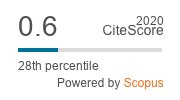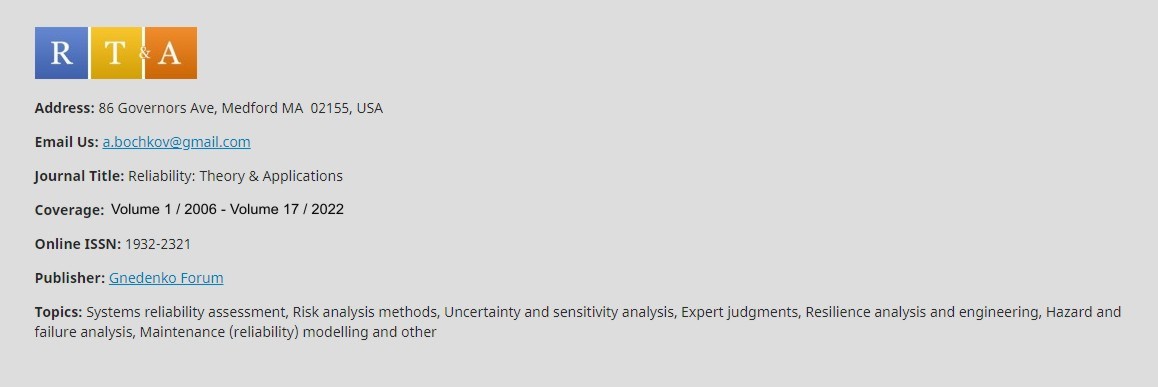|
About Us | Submission | Editorial Team | Privacy Statement | Current Issue | Templates & Author Guidelines | Archives | Contacts
|
||
|
|
Aditya Tiwary CUSTOMER ORIENTATED INDICES AND RELIABILITY EVALUATION OF MESHED POWER DISTRIBUTION SYSTEM
Reliability evaluation of a system or component or element is very important in order to predict its availability and other relevant indices. Reliability is the parameter, which tells about the availability of the system under proper working conditions for a given period. The study of different reliability indices are very important considering the complex and uncertain nature of the power system. In this paper reliability, evaluation of the meshed distribution system is presented. This paper also evaluates basic indices such as average failure rate, average outage time and average annual outage time. Along with basic indices, customer orientated indices such as system average interruption frequency index, system average interruption duration index and customer average interruption duration index of an electrical power distribution system is also evaluated. The electrical power distribution system taken for study is meshed distribution system in nature.
DOI: https://doi.org/10.24411/1932-2321-2020-11001
Anakha K. K., Chacko V. M ON EXPONENTIAL-WEIBULL DISTRIBUTION USEFUL IN RELIABILITY AND SURVIVAL ANALYSIS
In this paper, mixture of Exponential and Weibull distributions is considered for modelling real lifetime data. The basic mathematical properties including moments, generating functions, order statistics etc are derived. We obtain the reliability of stress-strength model. The maximum likelihood method is performed to estimate the parameters and a simulation study is conducted to validate the maximum likelihood estimators. The model is fitted to a real data set.
DOI: https://doi.org/10.24411/1932-2321-2020-11002
Irina Gadolina, Rashid Zaynetdinov BUILDING THE CONTINUOUS RANDOM PROCESS OUT OF THE SPECIFIED SEQUENCE OF TURNING POINTS FOR FATIGUE TESTING
The method of regeneration of continuous process is intended for the first place for the calculation of spectral density of regenerated process. The main feature of this method is preserving the values and sequence of turning points (extremes) given in “saw-kind” realization. While doing so, the methods which is based on cycle-counting methods will give the exactly the same fatigue durability estimation, because the initial condition MAX-MIN-MAX … is guaranteed. To investigate the random process standard deviation (RMS) by the spectral density, the extrapolation of the original sequence is provided by continuous cosine functions. Continuality of the process and its first derivative is ensured by the condition of compatibility at the turning points. To decide on frequencies, the information from some sample realizations obtained in exploitation was employed. As one of te applications, the method is intended to be used in the analysis of comparability of two competing approaches in the evaluation of loading in the tasks of evaluation of durability, namely, those that apply cycle-counting methods and which are based on the spectral density of processes methods. Some other speculations made on the modelled process are performed.
DOI: https://doi.org/10.24411/1932-2321-2020-11003
Rakesh Kumar, Sapana Sharma, Bhavneet Singh Soodan, P. Vijaya Laxmi, Bhupender Kumar Som TRANSIENT SOLUTION OF A HETEROGENEOUS QUEUING SYSTEM WITH BALKING AND CATASTROPHES
In this paper we consider a Markovian queuing system with heterogeneous servers, balking and catastrophes. The time-dependent behavior of the system is analyzed by using generating function technique. The expressions for mean and variance of the system are obtained in transient state. At last, some special cases of the model are derived and discussed.
DOI: https://doi.org/10.24411/1932-2321-2020-11004
Ritu Shaktawat, Rajdeep Singh Shaktawat, N. Lakshmi, Avinash Panwar, Arun Vaishnav A HYBRID TECHNIQUE OF COMBINING AES ALGORITHM WITH BLOCK PERMUTATION FOR IMAGE ENCRYPTION
In this paper, a hybrid approach for image encryption is proposed by combining AES, a standard cryptography algorithm, along with splitting and block permutation. A standard image (Lena) is taken as an input and to enhance the security, the image is divided into 4*4 matrix followed by block permutation before encryption of the image with AES. Comparison of various parameters with and without block permutation confirms the superiority of the proposed method in terms of better results after using splitting and permutation functions.
DOI: https://doi.org/10.24411/1932-2321-2020-11005
Gurami Tsitsiashvili, Marina Osipova VARIANCES OF LINEAR REGRESSION COEFFICIENTS FOR SAFETY MARGIN OF TECHNICAL SYSTEM
In this paper, we choose such a particular formulation of the problem of calculating linear regression coefficient, when the moments of observation form an arithmetic progression or depend in proportion to some degree of the observation number and variances of the estimation of the safety margin of the technical system decrease over time. It is proved that the variance of the trend estimation in this case decreases as a certain degree of the length of the series of observations. This makes it possible to evaluate the effectiveness of non-destructive testing for the safety margin of the technical system.
DOI: https://doi.org/10.24411/1932-2321-2020-11006
Andrey Kostogryzov, Petr Kanygin, Andrey Nistratov PROBABILISTIC COMPARISONS OF SYSTEMS OPERATION QUALITY FOR UNCERTAINTY CONDITIONS
For systems, including systems of intelligent manufacturing, information and intellectual systems, an achievement of operation quality at admissible expenses is very important and needs prognostic comparisons. Here the probabilistic approach to compare an operation quality of functionally similar systems for uncertainty conditions is proposed. To be compared there may be: different systems for an one operation time period or for different time periods with identical duration; or the same system for different time periods on time line. The system operation outputs are considered in the forms of material products, information products and products, combined from material and information products. For the given time of prediction the main results of the approach application are: a relative part of functions executed with admissible quality, estimations of expenses considering inadmissible system operation quality, a relative part of system operation satisfaction connected with quality and cost. The approach is demonstrated by examples
DOI: https://doi.org/10.24411/1932-2321-2020-11007
|
Safety Research :
Safety, Risk, Reliability and Quality:
Statistic, Probability and Uncertainty :
|
|
|
|
|
|
|
||







.png)
.png)
